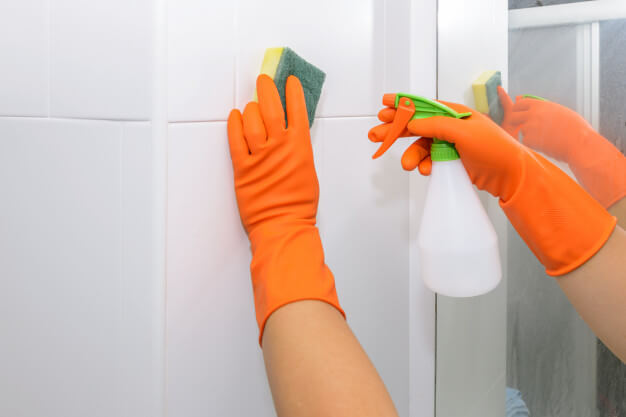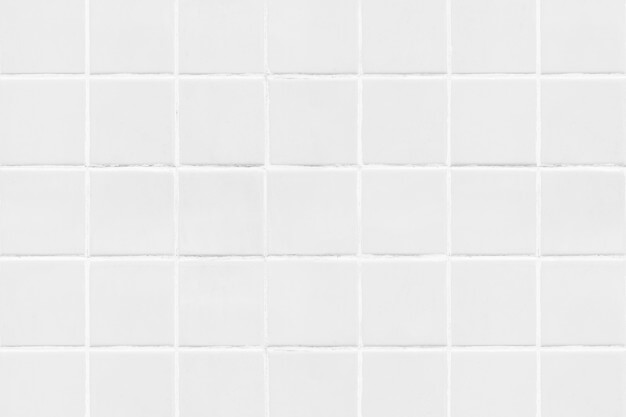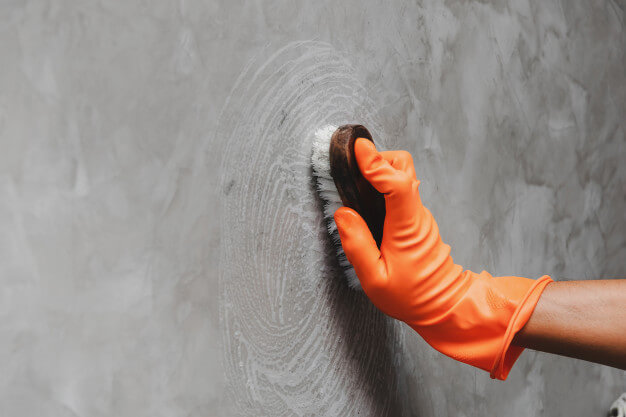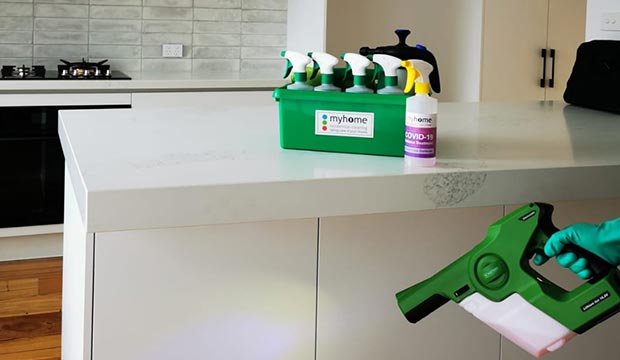Blog Two Simple Mould Removal Methods For a Wall or Ceiling - MyHome
Two Simple Mould Removal Methods For a Wall or Ceiling
Posted on Tuesday, January 1st, 2019

Mould is a common organism belonging to the family of funguses and yeasts that includes mushrooms. The spores are everywhere, but especially in damp places both indoors and outside. If you have mould growing on a wall or ceiling it not only looks awful, but it can be bad for your health so it needs to be cleaned right away. Many believe that the best method of mould removal is vinegar, however, others still swear by bleach. If you have a large area that needs mould removal you shouldn’t attempt to clean it yourself. Instead, consider professional cleaning services from Myhome or other cleaning providers.
Mould grows in wet or moist areas or where there is a lack of proper ventilation. The usual places to find mould are on walls and wallpaper, ceilings, in the tiles in the bathroom, on carpets – and in particular, carpets backed with jute. Mould also finds a home in wood and insulation materials. If there are any leaks, areas of high humidity and condensation, the mould can quickly build up in your home. To minimise the risk of mould growth, leave your windows open for longer and leave the front or back door open for a while each day.
Health Problems Due Mould:
Anyone suffering from asthma, allergies, or other breathing problems may be more sensitive to mould spores in the air, although mould is not good for even a healthy person. Anyone with a weakened immune system is more at risk, so mould removal and keeping your home clean and free from funguses is vital especially if you have young children or elderly people living in your home.

The Best Methods for Mould Removal
Most people believe bleach kills mould and prevents it from growing. But bleach will only kill surface mould on glass, tiles, basins, tubs and benchtops, and doesn’t work on porous materials. Bleach won’t kill the membrane beneath the mould on porous materials and if it isn’t removed, the mould just grows again. Mould membranes simply go deeper inside to escape from the bleach. Bleach is corrosive and can damage lungs, however, NSW Health(1) advises using diluted bleach and detergent for mould removal from small areas. Luckily, there is another household item that is less invasive and can kill mold: vinegar.
If you have a problem with mould on your wall or ceiling and you’ve rectified the moisture problem, then it’s time for getting down and dirty and choose a mould removal method. There are many ways of cleaning mould from a wall or ceiling, but the following two methods are used by most households:
Method 1: Mould Removal With Bleach
Bleach is the first thing most people reach for if they have an areas of mould that needs cleaning. It is a mould removal method and will kill surface mould as mentioned above. It will clean mould from anywhere, not just a wall or ceiling. Bleach kills the surface mould and bacteria but the jury is out on whether it stops the mould from returning.
You will need the following items if you decide to use bleach for cleaning:
- A bucket
- Bleach (chlorine)
- Water
- Safety glasses and shoes
- Gloves (bleach can irritate and burn the skin)
- Microfibre cloths
- A ladder
- A mask (so you don’t breathe in the vapours and end up with lung problems)
- A safe ladder
- An old toothbrush
Step 1:
Open the windows so you have plenty of fresh air in the room and for drying the wall or ceiling (or both) later. Put the mask, safety glasses, shoes and gloves to protect you from both the bleach and exposure to mould. Make up a solution in the bucket of one part bleach with 10 parts water.
Step 2:
Dip one microfibre cloth in the bleach solution and squeeze most of the liquid out. Wipe the mould away in a circular motion. Don’t rub too hard or you might remove paint. If the water gets too dirty you should make up a clean solution. Use the toothbrush for cleaning mould from difficult areas. Use the ladder to reach the ceiling areas and top of the wall for mould removal.
Step 3:
When you’ve finished cleaning your wall or ceiling, take a dry microfibre cloth and press it against the cleaned areas – don’t rub – to soak up the residual solution. Don’t rinse the wall or ceiling at all because leaving the bleach solution on the area may help prevent more mould growth on the surface.
At Myhome, our aim is to leave your home brilliantly clean and you 100 percent happy with the result. That’s our passion and dedication that we offer you with the Myhome guarantee: if you’re not completely happy with the result we will do it again free of charge!

Method 2: Mould Removal with Vinegar
Many people prefer to use vinegar as a cleaning aid for almost everything, including mouldy walls and ceilings because it is natural and completely safe. Vinegar can kill more than 80 percent of mould species found in households. It is mildly acidic and can help prevent mould growth as well as removing it. Vinegar doesn’t burn or irritate the skin and it doesn’t give off vapours the way most chemicals do. The only downside to vinegar for cleaning is that while it does kill mould and prevents it from recurring, it has to be done more regularly than if you used bleach. Use the protective glasses and shoes, mask etc to protect you from the mould. For stubborn mould, mix two cups of water and a teaspoon of baking soda into another spray bottle, shake it up and spray it on the area.
You will need the following items to clean a wall or and ceiling using vinegar.
- White distilled vinegar
- Baking soda
- Water
- A bucket
- A spray bottle
- Clean microfibre cloths
- A scrubbing brush
- A safe ladder
Step 1:
Open the windows. Fill the spray bottle with straight vinegar, no water, then spray the mouldy areas and leave it for one hour.
Step 2:
Fill half the bucket with water, dip a microfibre cloth in and wring it out, though not super tight. Wipe away the mould from the areas where you sprayed the vinegar. You can also use a scrubbing brush and a solution of baking soda for stubborn mould removal, but again, don’t scrub the paint off.
Step 3:
Press a dry microfibre cloth against all the cleaned areas. Spray the area with straight vinegar again and leave it to dry naturally. Leave the windows open to help dry the cleaned areas faster.
Step 4:
Keep your spray bottle filled with vinegar so you can apply it once or twice a week to the areas prone to mould growth.
Keep Your Home Mould-free
Controlling dampness and moisture in your home is crucial in preventing mould growth. To avoid the problem, make sure all leaks are repaired, all gutters and drains are clear and unblocked. If water does get into your home, you should clean and dry everything and if the damage is too severe then replace carpets, insulation, furniture and building materials. Good Ventilation is key to keeping your home clean and free from mould. Use your exhaust fans after hot showers, in the kitchen when cooking or in the laundry if using hot steamy water. Open windows to increase cross-ventilation in good weather. Other tips include:
- Use humidifiers less often
- Cull your indoor plants and fish tanks
- Don’t use unflued gas heaters
Rising Damp
When ground moisture rises up into a brick or stone wall it’s called ‘rising damp’ and mould will happily grow there. Dampness rises if there is poor ventilation, or worse, moisture in the sub-floor. A ‘damp course’ is the usual solution to this problem as it creates a waterproof barrier. Keeping air vents and weep holes uncovered is highly recommended so air can get to the subfloor and dry any dampness, which deters mould.
Cleaning mould from walls and ceilings is not a pleasant task and if you suffer from allergies or have respiratory problems, it can be very unpleasant. If you’re a busy mum or you’re busy at work, Myhome can do the job for you and ensure no mould particles get on your furniture or contaminate the air. Call us today on 132231 for a quote.
Reference:
https://www.health.nsw.gov.au/environment/factsheets/pages/mould.aspx
Filed under: Residential Cleaning




